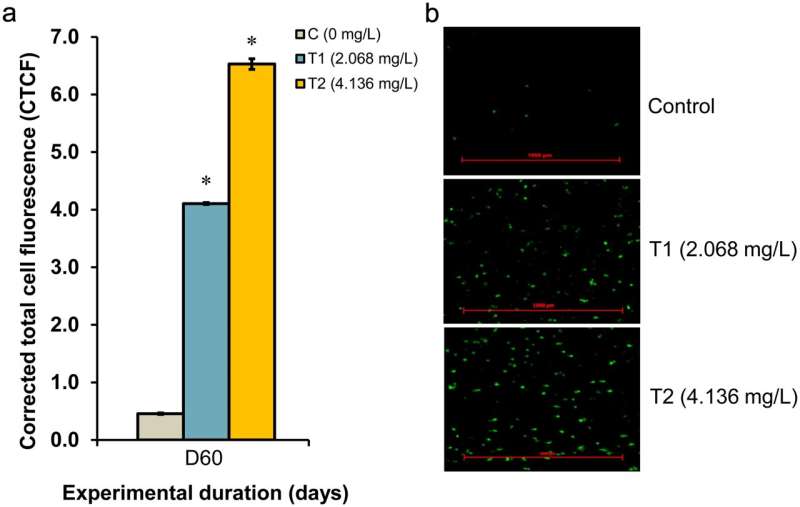This article has been reviewed according to Science X's editorial process and policies. Editors have highlighted the following attributes while ensuring the content's credibility:
fact-checked
proofread
Perturbations in redox status, biochemical indices, genes in the liver following fish exposure to Mancozeb

Due to the increased demand for food for the growing population, pesticides are widely used to control diseases and boost productivity. A study published in the journal Gene Expression was designed to evaluate the toxic effects of the fungicide Mancozeb (MZ) in the liver of the fish strain Channa punctatus.
Fifty-four healthy C. punctatus fish (24 ± 4.0 g, 11.0 ± 2.0 cm) were divided into three groups (n = 18 per group): control, T1 (20% of 96 h-LC50—2.068 mg/L) and T2 (40% of 96 h-LC50 − 4.136 mg/L). Reactive oxygen species, redox imbalance, and liver biomarkers were measured after 20, 40, and 60 d of MZ exposure. Transcriptional profiling of XBP1s and NOX4 genes was performed after 60 d.
There were significant (p < 0.05) increases in reactive oxygen species induction, oxidative stress biomarkers (lactate dehydrogenase enzyme activity, glutathione peroxidase, superoxide dismutase, and catalase), and liver biomarkers (alanine transaminase, aspartate transaminase, alkaline phosphatase, and total bilirubin) after 20, 40, and 60 d of MZ exposure.
However, there were significant (p < 0.05) decreases in superoxide dismutase and catalase after 40 d. There was a significant (p < 0.05) upregulation in XBP1s (5.1-fold) and NOX4 (3.3-fold) gene expression in the T2 group after 60 d. These results collectively evince the inflammatory response triggered by MZ. It may serve as early bio-indicators of endoplasmic reticulum stress and in the prevention and treatment of liver diseases.
This study showed that MZ is a strong oxidative stress inducer that can trigger NOX4 and XBP1s gene expression in the liver. We also found that ROS levels and their related biomarkers were elevated during liver injury, indicating that MZ toxicity can exert its toxic effects even in sub-lethal concentrations in C. punctatus fish.
It is well known that ROS overproduction can cause neurodegenerative diseases, cancer, and liver diseases. Future studies will focus on the possible molecular pathways that are affected by MZ toxicity, contributing to a better understanding of disease progression.
More information: Adeel Ahmad Khan et al, Perturbations in Redox Status, Biochemical Indices, and Expression of XBP1s and NOX4 in the Livers of Channa Punctatus Following Exposure to Mancozeb, Gene Expression (2024). DOI: 10.14218/GE.2023.00049
Provided by Xia & He Publishing Inc.

















